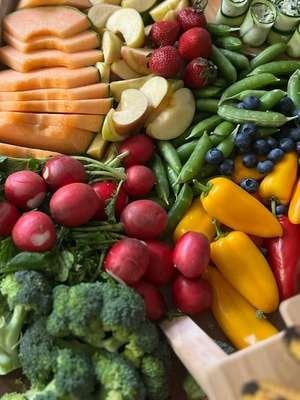Think You're Smart? Most Aussies Fail to Answer This Deceptively Simple Question – Can You?
By
Danielle F.
- Replies 11
It's a question that seems straightforward enough, but a recent survey has shown that the majority of Australians might not be as clued-up on their greens as they think. The simple query that stumped more than three-quarters of Aussies was: What is the definition of a vegetable?
The survey, which involved over a thousand participants, revealed an alarming truth about our collective knowledge on nutrition. Only fewer than 25 percent of those surveyed could accurately define a vegetable, even in the broadest sense. For clarity, a vegetable is any edible part of a plant, including leaves, stalks, roots, bulbs, and flowers. While fruits are technically a subset of vegetables, particularly the sweeter varieties, they are often categorized separately due to their distinct flavors and uses.
This widespread misunderstanding is more than just a trivial knowledge gap. It reflects a deeper issue within our dietary habits. The confusion over what constitutes a vegetable leads to misconceptions, such as the belief that vegetables cannot contain seeds – a notion easily debunked by the existence of seeded veggies like pumpkins, capsicums, tomatoes, cucumbers, and eggplants. Others mistakenly think that all vegetables grow underground, overlooking above-ground varieties like cabbage, lettuce, broccoli, and corn.
Why does this matter? The implications are significant for our health. A mere five percent of Australians meet the minimum recommended daily intake of vegetables – that's six cups for men and five cups for women, in addition to two cups of fruit. The rest of us are filling up on processed foods high in energy, sugar, and salt, leading to a nation that is, on average, fibre deficient and at an increased risk of heart disease, diabetes, stroke, and other health issues.
Incorporating five to six servings of vegetables into your daily diet still leaves plenty of room for other food groups, including meats, cheeses, carbs, and the occasional treat. Achieving the government's dietary recommendations doesn't require a drastic lifestyle change, just smarter choices. However, for many Australians, making these choices is more challenging than it should be.
Take, for example, the experience of trying to consume six servings of vegetables in a day. A typical breakfast might consist of cereal and milk, leaving the challenge of fitting in multiple servings of vegetables for lunch and dinner. Dining out often proves fruitless in this endeavor, with many menus offering scant vegetable content beyond a token slice of tomato or lettuce leaf.
The prevalence of ultra-processed foods in Australian cuisine is partly due to the commercial benefits they offer to sellers. A local café might have bananas in stock, but they're more likely to sell you banana bread, which is more profitable due to the added cheap flour and sugar. This 'added-value' approach has shaped much of the Western diet, promoting the consumption of energy-dense, nutrient-poor foods and contributing to a host of health problems.
Turning to home cooking might seem like a solution, but it comes with its own set of challenges. Preparing a vegetable-rich breakfast or meal requires more time and effort than many of us can spare, given our busy schedules. Moreover, keeping a fresh variety of vegetables on hand might necessitate multiple shopping trips per week, which is a daunting prospect for most.
So, what can be done to increase vegetable intake with minimal fuss and expense? Christina Turner, an accredited practicing dietitian and clinical lead for the Master of Nutrition of Dietetic Practice program at Bond University, offers some practical advice:
Vegetables are not only easy to cook and store but also increase our fibre intake and reduce our consumption of unhealthy ingredients. They're better for the environment, and eating them supports local farmers. It's a win-win situation that calls for a shift in our eating habits, placing vegetables at the forefront of our plates and menus.

Now, dear readers, it's your turn to reflect. How would you define a vegetable? Are you meeting your daily recommended intake? Share your thoughts and strategies for incorporating more veggies into your diet in the comments below. Let's inspire each other to make healthier choices and enrich our diets with the bounty of vegetables available to us.
The survey, which involved over a thousand participants, revealed an alarming truth about our collective knowledge on nutrition. Only fewer than 25 percent of those surveyed could accurately define a vegetable, even in the broadest sense. For clarity, a vegetable is any edible part of a plant, including leaves, stalks, roots, bulbs, and flowers. While fruits are technically a subset of vegetables, particularly the sweeter varieties, they are often categorized separately due to their distinct flavors and uses.
This widespread misunderstanding is more than just a trivial knowledge gap. It reflects a deeper issue within our dietary habits. The confusion over what constitutes a vegetable leads to misconceptions, such as the belief that vegetables cannot contain seeds – a notion easily debunked by the existence of seeded veggies like pumpkins, capsicums, tomatoes, cucumbers, and eggplants. Others mistakenly think that all vegetables grow underground, overlooking above-ground varieties like cabbage, lettuce, broccoli, and corn.
Why does this matter? The implications are significant for our health. A mere five percent of Australians meet the minimum recommended daily intake of vegetables – that's six cups for men and five cups for women, in addition to two cups of fruit. The rest of us are filling up on processed foods high in energy, sugar, and salt, leading to a nation that is, on average, fibre deficient and at an increased risk of heart disease, diabetes, stroke, and other health issues.
Incorporating five to six servings of vegetables into your daily diet still leaves plenty of room for other food groups, including meats, cheeses, carbs, and the occasional treat. Achieving the government's dietary recommendations doesn't require a drastic lifestyle change, just smarter choices. However, for many Australians, making these choices is more challenging than it should be.
Take, for example, the experience of trying to consume six servings of vegetables in a day. A typical breakfast might consist of cereal and milk, leaving the challenge of fitting in multiple servings of vegetables for lunch and dinner. Dining out often proves fruitless in this endeavor, with many menus offering scant vegetable content beyond a token slice of tomato or lettuce leaf.
The prevalence of ultra-processed foods in Australian cuisine is partly due to the commercial benefits they offer to sellers. A local café might have bananas in stock, but they're more likely to sell you banana bread, which is more profitable due to the added cheap flour and sugar. This 'added-value' approach has shaped much of the Western diet, promoting the consumption of energy-dense, nutrient-poor foods and contributing to a host of health problems.
Turning to home cooking might seem like a solution, but it comes with its own set of challenges. Preparing a vegetable-rich breakfast or meal requires more time and effort than many of us can spare, given our busy schedules. Moreover, keeping a fresh variety of vegetables on hand might necessitate multiple shopping trips per week, which is a daunting prospect for most.
So, what can be done to increase vegetable intake with minimal fuss and expense? Christina Turner, an accredited practicing dietitian and clinical lead for the Master of Nutrition of Dietetic Practice program at Bond University, offers some practical advice:
- Utilize frozen or tinned vegetables, which save on meal prep time, are cost-effective, and retain their nutritional value.
- Incorporate legumes into your diet as a vegetable and protein source, offering a cheaper alternative to meat.
- Purchase seasonal and 'ugly' fruits and vegetables, which are often discounted.
Vegetables are not only easy to cook and store but also increase our fibre intake and reduce our consumption of unhealthy ingredients. They're better for the environment, and eating them supports local farmers. It's a win-win situation that calls for a shift in our eating habits, placing vegetables at the forefront of our plates and menus.
Key Takeaways
- Fewer than 25 per cent of Australians surveyed knew the correct definition of a vegetable.
- Misunderstandings about what constitutes a vegetable contribute to Australians eating below the recommended daily servings.
- Australians are replacing vegetables with processed, sugary, and salty foods, contributing to health issues.
- Christina Turner, a dietitian, recommends using frozen or tinned vegetables and legumes to increase vegetable intake with minimal fuss.








